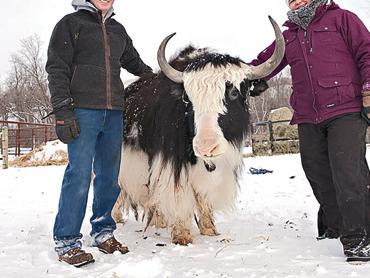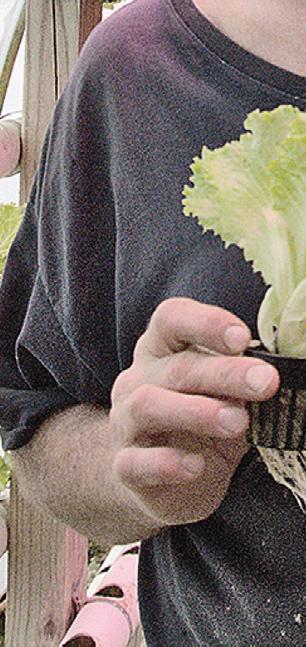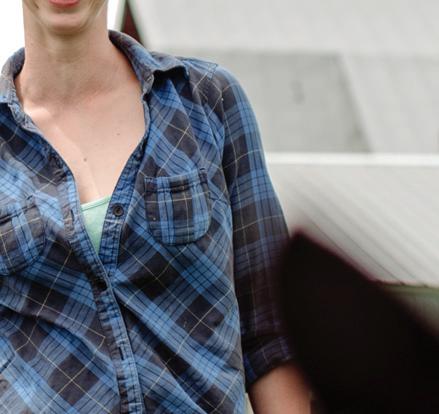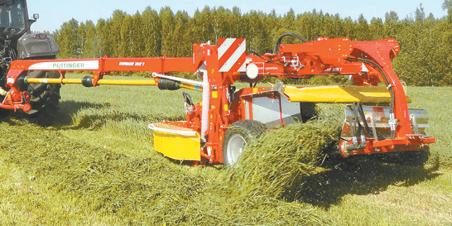been

A ripe tomato hangs on a vine at Serio Farms Nov. 16 near Preston. The farm has 350 tomato plants with plans to grow more.
ston. rdening s


























been

A ripe tomato hangs on a vine at Serio Farms Nov. 16 near Preston. The farm has 350 tomato plants with plans to grow more.
ston. rdening s

























PREST Ser garden his life as a d h a hydro ever he had, includin care launch business with 48 and his own self-de system To d







PRESTON –Andrew Serio had been gardening all his life as a hobby. In 2014, he decided to combine his love of gardening and his interest in hydroponics to forge a new career. Serio worked several jobs and sold everything he had, including his cattle, to invest in his venture. After careful research, he launched his business with 48 tomato plants, 300 lettuce plants and his own self-designed hydroponic system.
Today, his business, Serio Farms, has grown to serve not only the Rochester Farmer’s Market, but also the Chatfield Farmer’s Market. Additionally, he provides fresh products to People’s Food Coop, Parkway Grocery Store, the Lanesboro Sales Barn, and restaurants like Stellar 81 Taphouse, Juniper, Blue Duck and Four Daughters. In addition to tomatoes and lettuce, the farm also supplies rosemary, mint and basil.

“I enjoy
A row of tomatoes grows on Serio Farms. The Serios use hydroponics to grow tomatoes and lettuce.


making people happy with fresh products,” Serio said. Because hydroponic farming uses water instead of soil to grow the plants, Serio can provide fresh produce to his customers year-round. He puts vitamins, minerals, and any other necessary products the plant specifically needs to grow, directly into the water. He said it actually uses 90% less water than growing plants conventionally.
Demand has grown
so much that Serio now harvests from 350 tomato plants and 2,500 lettuce plants. He has two greenhouses and is planning to put up two more in the next five years. When he first began his business, the bank wouldn’t loan him the money to grow vegetables or invest in a necessary second greenhouse to ramp up his hobby into something profitable.
Published by Star Publications












Copyright 2014

522 Sinclair Lewis Ave. Sauk Centre, MN 56378
Phone: 320-352-6577 | Fax: 320-352-5647


Mark Klaphake, Editor, mark.k@dairystar.com
Grace Jeurissen, Editor, grace.j@star-pub.com

Taylor Jerde, Writer, taylor.j@star-pub.com
Tiffany Klaphake, Writer, tiffany.k@dairystar.com
Ben Sonnek, Writer, ben.s@saukherald.com
Story ideas send to: grace.j@star-pub.com, mark.k@dairystar.com


Laura Seljan, 507-350-2217, laura.s@dairystar.com
Julia Mullenbach, 507-438-7739, julia.m@star-pub.com
Missy Traeger, 320-291-9899, missy@saukherald.com
Tim Vos, 320-845-2700, tim@albanyenterprise.com






Mike Schafer, 320-894-7825, mike.s@dairystar.com


Warren Stone, 320-249-9182, warren@star-pub.com
Jaime Ostendorf, 320-309-1988, Jaime@star-pub.com
Bob Leukam, 320-260-1248, bob.l@star-pub.com




“They told me, I’m not giving you money to grow tomatoes,” Serio said.
At the time, Serio was raising cattle, but he sold his herd and everything else he had, even his pickup truck, to put up the funds for his entrepreneurial dream. He worked two full-time jobs for four years, driving truck and working in a greenhouse to save money.

In the beginning, he received some push back.
He first went to the Rochester Farmer’s Market, bringing some tomatoes along with him. He had brought 60 pounds of tomatoes, and it took him nearly four hours to sell all of them.
“Customers couldn’t believe the tomatoes were fresh and were hesitant,” Serio said.

However, his tomatoes and growing method were quickly embraced. Two weeks later, he brought 110 pounds of tomatoes and sold out
in just 45 minutes.
Serio works alongside his wife, Jenny, who helps with the lettuce, harvesting and transplanting. His father, August, who is 87, also helps
out as much as he can and is the delivery person.
Serio said his parents have helped him accomplish the many goals he has set. They were dairy farmers in Winona. When Serio turned 19, he purchased the farm from them. Even then, he knew he enjoyed working with plants more than animals. He sold the farm shortly after and moved to Preston to raise Holstein steers while also gardening.
ISSN Print: 2834-6491 | Online: 2834-6505
Deadlines:
Country Acres will be published the first and third Saturday of every month. Deadline for news and advertising is the Thursday before publication.







The Serio and his wife have been on their current farm for 20 years. Serio plans to fill four acres of the 10-acre farm with garden. His goal is to increase his tomato production by 3,000 pounds of tomatoes per week within the next five years. He currently produces about 200 heads of lettuce each week, and his tomato plants can produce one pound of tomatoes per plant each week.
ting tingling too…















As the year comes to a close and I am overwhelmed with the excessive need to be everywhere all at the same time, holiday tunes are the only things that seem to give me a clear head on my drives from the farm to the office or in the tractor while hauling manure.














 of Grace by Grace Jeurissen
of Grace by Grace Jeurissen





I have been listening to holiday tunes since early November. When it comes to the holidays, I thoroughly enjoy the festivities and traditions that come about.




For the sake of my family, mostly my fiancé, I refrain from setting up decorations until after Thanksgiving.
I’ve always loved this time of year. I love the family gatherings, gift giving and food. More importantly, I love going to church during the holiday season. It’s beautiful when they deck the halls of the church in red, green and gold.


This season tends to be busy but fun.





“Inhale…exhale,” I always tell myself when I get overwhelmed. I also ask myself, “Why did you double-book yourself, again?”

Topping the cake of my busy schedule is the need everyone seems to have for giving me wedding advice. I reply with polite nods and yes-oh-fer-sures, unless I asked for their opinion. In my head I’m thinking, “Get me out of here.”
It makes me yearn for when our relationship was fresh and new, in its baby stage yet. No one gave opinions about what we should or shouldn’t do when wedding planning wasn’t involved.
John was new to the family, and we were mid-pandemic when everything was still shut down. We decided to do a small holiday gathering with my siblings, parents and nephews.
I was in charge of dessert, and it was requested that I make cheesecakes. Reese’s and cookie monster cheesecakes are what I made that day, and they looked delicious. I was so proud of myself that I posted the
cheesecakes on my social media.
John was getting antsy to head to the gathering, so I asked him to take the Reese’s cake to the truck. The cake was on a glass cake stand so that it could be showcased in all of its glory. I went upstairs to finish my makeup, but I suddenly got a weird feeling.
Brushing it off, I grabbed the second cheesecake and walked outside. I opened the door and…



I’ve only been hysterically upset once, and it was then. There on the asphalt was half of my cheesecake. On the platter was the now-deformed second half that had taken me 24 hours to perfect.



This was also the one time I (momentarily) thought of breaking up with John.




He explained how he had tripped over a crack in the asphalt and sent the cake sliding off the glass plate. He sported a look of embarrassment and fear. Anyone who knows me knows that I take my cheesecake making seriously.
I understood that it wasn’t logical to get angry over the situation, but I couldn’t help a mix of anger, hysteria and sadness bubbling up inside of me. I sat in silence on the way to my sister’s house, in my head reviewing the Criminal Minds episodes I had watched.


I walked in and through gritted teeth told the story. My brother-in-law chimed in, saying, “It’s rocky road surprise now.”
We still ate the cheesecake. We just had to pick out the pebbles from some of the pieces.
A photo from that gathering comes up as a memory on my phone, and I still get a little pinch of anger. I haven’t let my fiancé carry food to family gatherings since then.
They say a good marriage is built on trust. I trust John with my life, just not with my cheesecake.
So, this is my Christmas wish: May we all find peace on earth by handling challenges with composure.



The work is not without its challenges. Serio has overcome a number of difficulties, such as last summer when a mold killed all the tomato plants in one of his smaller greenhouses.







The molds continue to get stronger each fall, he said.

He also battles with bugs all year since he creates such a warm environment for the tomatoes. Serio tries to be as natural as possible, but hydroponics makes it a little more challenging, he said.
“Every day is a surprise,” Serio said.



While there are unique challenges to hydroponic gardening, Serio appreciates the plants for their simplicity.



“Tomatoes are kind of the closest thing to humans, they need to have about the same body temperature as we do,” he said. “If I am out here in a sweatshirt, then it’s too cold for them.”
As Serio expands the business, he’s also expanding product lines that make use of unsold produce. He has created a roasted tomato sauce and just began growing hot peppers, including ghost chilies and Habaneros. He ferments the peppers for a year and then uses them to craft his newest creation: Angry Dog Hot Sauce, in honor of his dog Pepper who passed away last year.
Looking to the future, Serio is working on expansion plans. He hopes eventually a new family will be interested enough in what he is doing to come in and learn about hydroponics with the goal of eventually taking over the farm. That family could experience the joy that Serio has found in his business.
“I enjoy being able to go outside and have freedom to be my own boss,” Serio said. “I’m proud to be able to do what I love.”




























Mike Veiseth is the fourth generation of Veiseths to farm their land in Goodhue County just outside of Zumbrota. Mike and his brother, Dennis, partnered 30 years ago to continue operating the family farm. The farm has always been a dairy farm with other species mixed in at various times in the early years. Over the past three decades, Mike and Dennis made various changes and improvements to the operation including the addition of a bedded pack shed, a stack and slab manure handling system, and they added a swing-ten parlor onto the existing tie-stall barn. The Veiseths also partnered with the University of Minnesota to add an upgraded milkhouse waste treatment system.
Currently, the family milks 80 cows in a swing-ten parlor that was built in 2014. The Veiseths use conservation practices including contour strips and grass waterways. The farm’s 400 acres produce corn, corn silage and alfalfa. A small beef herd of 30 head is also part of the family’s business.




The family aspect of running a farm has always been important to the Veiseths. In the past, Mike’s nephews have all worked on the






farm and currently Mike’s daughters assist.



Mike is the owner/operator of the farm; his wife, Casey, is a speech pathologist and chief household manager. Mike and Casey have three daughters. Kjersten is a recent University of Minnesota graduate who assists with milking and general farm chores and is employed by Ag Partners in Plainview. Liv will be attending the University of Minnesota this fall majoring in environmental sciences and Liesl attends Goodhue schools. Liv and Liesl also help with general farm chores.
Mike and Casey serve on the Goodhue County American Dairy Association board where Mike has been the chair for the past six years. The family has been active in the Goodhue County 4-H program for 17 years. Casey has been a local 4-H club leader, served on county project committees and has been involved with the county 4-H council. The family actively supports their local school and the many activities that their daughters have been involved in. Mike works as the statistician for the Goodhue Wildcats football team. The Veiseths are very involved in their church.







 STAFF WRITER
STAFF WRITER



































































raptors, giving them an opportunity to perfect their hunting skills and share in their lives before releasing them back into the wild.
“It’s a very unique sport,” Standlee-Hanson said. “We often talk about it being a passion and a way of life. It’s living with that bird and trying to give them the best possible life. We’re not keeping a pet; we’re keeping a hunting partner.”

After a season or two as a falconry bird, the raptors are more fit, more experienced and able to live on their own, she said. Studies show that roughly 70 percent of wild first-year birds die in the course of a year because they do not learn how to hunt or they get injured.

“If they make it through their first year, they can then go on to live 20 years in the wild,” she said.
Standlee-Hanson’s interest in falconry and hawking started when she moved from Texas to Wisconsin and heard a feature on NPR. To date, she has trained 21 birds, usually keeping a bird for one or a few seasons. She’s had several apprentices through the years and has continued to train hawks throughout that time – including a male American Kestrel at one point.
Seneca, Carolyn Standlee-Hanson’s Red-tailed Hawk, perches in a traveling crate before her flight Nov. 22 near St. Charles. Standlee-Hanson page 7







Her current bird is a female Red-tailed Hawk she named Seneca, in Standlee-Hanson’s opinion, one of the best types of birds for beginning trainers.
“She will teach you to respect her with her feet,” Standlee-Hanson said. “They’re quite powerful and intimidating, and you learn to understand them and be calm with them. You can’t train the bird with punishment; it’s only positive reward and calm manner.”
Those strong feet are one of the features that distinguishes a hawk from a falcon. On a hunt, a falcon kills with its beak while a hawk kills with its feet.
Standlee-Hanson said that she thinks of the Red-tailed Hawk as the Boeing B-52 of raptors; they are big, beefy, strong and relatively slow birds, making them good at catching rabbits and squirrels but, unlike falcons, not as good at catching ducks. She has also trained Harris Hawks, similar to Red-tailed Hawks but lighter and with more of a pack mentality.
Hawks are trained to hunt with their hunger, she said. When hunting season approaches, trainers will give the hawks less food and more exercise to lean them down and get them in the weight range where they are ready to search for prey.








“We have a term which is usually applied to goshawks, but it’s called ‘in yarak,’” Standlee-Hanson said. “That’s that keenness, that ‘I want to hunt.’ When your bird is hungry and ready to hunt, they have a sharpness about them and are ready to take on that task.”
Although the falconry term generally means hunting wild quarry with a trained raptor, Standlee-Hanson does what is called dirt hawking, not classic falconry. In falconry, the falcon flies high, and dogs flush out the game birds for the falcon to strike out of the air, which they do in a “stoop” or dive that reaches over 200 mph, a faster speed than any other animal on the planet. In dirt hawking, the handler or a trained dog is the one on the ground, beating
through the brush to disturb rabbits and squirrels while the hawk sits in a tree or other high place nearby.
“It’s a unique experience,” Standlee-Hanson said. “It’s one of the few activities where you can go and be a part of that elegant dance between predator and prey. The misses are almost more exciting, when the bird doesn’t catch the game.”
Squirrels in particular make interesting misses, she said. Once the game has evaded capture by hiding in a hole, they will sass the hawk and trainer.
“If you could speak squirrel, they’d probably be cussing us out,” Standlee-Hanson said.
In the past, falconers and hawkers relied on bells to locate their birds. Nowadays, birds can have radio transmitters on them, and some highend birds have GPS-enabled telemetry devices. Standlee-Hanson uses the radio transmitter, but she leaves her radio receiver and antenna behind unless a bird goes missing, which has only happened a few times.

“We still use the bells,” Standlee-Hanson said. “When you’re in the fi that’s the only way you can hear the bird.”

Standlee-Hanson has many places she has discovered over the years where she has permission to hunt, areas where the game is and the people are not. For her, hunts usually take about an hour or so – not as long as some falconers, but she also has to take care of her home and other animals, including goats.
To learn the skill of falconry, Standlee-Hanson apprenticed under Dave Noble, who lived just five miles from her. After passing an exam with the fi department, and getting the right facilities and equipment, her falconry journey began in 2002. The bells she uses today were made by her mentor.
Carolyn Standlee-Hanson carries her Red-tailed Hawk and her catch, a rabbit, Nov. 22 near St. Charles. Standlee-Hanson has trained 21 hawks to date, usually keeping them for one or a few seasons before releasing them.

22 near St. Charles.

The largest and most expensive facility Standlee-Hanson needed to acquire was a mew – an outdoor, shed-like hawk house with windows and perches.
“Later on, especially if you move on to accipiters (a bird of prey genus) or falcons, many people will have freestanding perches in their living room,” Standlee-Hanson said. “Continued contact with people is what helps keep birds manned – used to being around people –but you always have to have a dedicated facility to put them in.”
Standlee-Hanson also had to make a weathering yard, a place where a bird can be safely tethered outside so it can sit out in the weather.

“It’s good for their mental stability to be outside when you’re not handling them,” Standlee-Hanson said.
Other needed items included a leather gauntlet, a falcon hood and hunting gear. The list of necessary gear can vary depending on the state law.
“We still report to the federal government because what we’re handling is a



federally-licensed raptor,” Standlee-Hanson said. “It’s a wild animal that’s managed by the U.S. Fish and Wildlife Service, so you are allowed to interact with and have these birds as long as you’re following the laws that have been set up for it.”
Once Standlee-Hanson had her falconry license, Noble took her through the process of trapping her first bird, a Red-tailed Hawk she named Scimitar. A license is needed before anyone can trap a raptor.
“In America, we are unique in the world in that we still retain the right to be able to trap birds from the wild,” Standlee-Hanson said.

After their first year, birds can get a lot harder to train and can be easier to spook; prior to that, they are less suspicious of humans and are easier to trap, she said. Wild-trapped hawks, unlike birds from falcon or goshawk breeders, can also be released back into the wild because they have not imprinted on humans, so if things do not work out between the bird and trainer, the bird can simply be let go.
Training a first-year hawk is somewhat of a conservation effort because of the bird’s increased survival chances on release. Many falconers are also conservationists, biologists and veterinarians.
“They come with a set of instincts already there,” Standlee-Hanson said. “Instincts are one thing; technique is something else. Sometimes, they get better technique if they have the opportunity to practice, which is what we give them while we’re hunting – but, at the end of the day, if they didn’t catch any food, we’re still going to take them home and feed them, so they have that window of opportunity to perfect their skills.”
Guided by Noble, Standlee-Hanson began training Scimitar. The initial stages involved simply getting the hawk to not fear her, and that was done by holding the bird on her fist throughout the day – work-
ing at home, watching TV and just doing everyday activities. Then, it was a matter of communicating with the bird with food, and once the bird accepts food from their handler, the training process can proceed.
“The training process is actually quite quick,” Standlee-Hanson said. “You can have a wild-trapped bird ready to go in about three or four weeks. Once you make that bridge with food, you can move along quite quickly.”
Standlee-Hanson knows when it is time to release a bird because they will start to push back against her and become less responsive. When on hunts, they will sometimes be more interested in challenging other birds, a sign they are looking for their own territory.



“Once they hit three years, they want to move on with life,” Standlee-Hanson said. “They want to find a mate (and) go make a nest, so I usually don’t keep one much longer than that. A lot of falconry is paying attention to the subtle signs the bird gives you. They have limited emotion, but frustration is one they can definitely express – and anger.”
When it comes time to release the bird, Standlee-Hanson knows it is harder for newer trainers and young apprentices. She, however, always feels good when she lets the bird go and is grateful to it for sharing its lives with her.
Standlee-Hanson has documented many of her hawking experiences on her blog, http://phoenixfirefalconry.blogspot.
com. Looking back on those memories and more throughout her 20-year career, she gets a profound sense of calm and appreciation for wild things.
“I’m out, I’m in the middle of the woods (and) I’m far enough away that I don’t hear the noise of civilization,”
Standlee-Hanson said. “It’s just me and the bird, and I’m getting to watch that ancient dance of predator and prey, and whether you catch something or not, it lends a sense of peace.”





























The next year s to a g winn






The next year she had to provide a goat for the next winner.
“Blossom started my goat herd, and before I knew it I had three goats to milk,” Bonow said.
ed goat goats to m Bonow d w to the e milk the g so de to start m cheese.”
“We didn’t know what to do with the extra milk from the goats, so I decided to start making
kitchen, experimenting with semaking, w an award at her
From her mom’s kitchen, Bonow began experimenting with cheesemaking, even winning an award at her county fair after submitting her cheese for the Food and Nutrition category her final year in 4-H.
Her cheese can now be found on several cheese retail counters like Lunds & Byerly’s, as well as several other restaurants and retial locations through out the Twin Cities. This was a goal of hers since she began making artisan cheese more of a career than a hobby while in college.

Bonow pursued a degree in Italian studies through the University of Minnesota. This landed her abroad in Italy where she had the opportunity to work on an organic farm that made cheese.

After coming back to the states, Bonow sought out more education on cheese making at the Vermont Institute of Artisan Cheese in Burlington, Vermont. She learned the ins and outs of artisan cheeses and her desire to make savory cheese using the milk from her goats increased.
“I’m still a newcomer in the artisan cheese business, but I have got-




PHOTOS SUBMITTED (Above) Contadina cheese sets on racks in the Capra Nera Creamery aging room. The aging room has to be around 80% moisture to promote proper rind development.
(Right) Cheeses
ten positive feedback from customers that have tried my cheeses,” Bonow said. “My personality enjoys doing the process and having an end product. It is extremely rewarding to see my cheeses packaged and ready for someone to enjoy.”
Since she began her on-farm creamery, Bonow has noticed how more mainstream it is becoming to reach for goat cheese as food option instead of it being considered a health-conscious option or delicacy.


There are many myths that goat cheese is healthier or lactose free, Bonow said. Goat milk has lactose
like regular cow milk. The largest differences between the two dairy options are the proteins and fats in the milk. Goat milk carries an A2 protein which can also be found in cow milk, but is less common.
Dairy from both are regular products in Bonow’s refrigerator at home. She milks goats and creates goat cheeses, while her husband, Ryan, milks cows with his family. Both of the Bonow’s children, Oren ,4, and Lyla, 1, enjoy dairy for snacks and with meals.
“Dairy is a great food product,” Bonow said. “In

fact, Oren enjoys when I make cheese because he gets to be the taste tester.”
Creating one-of-akind cheeses can be a delicate process because the fats in goat milk are easily damaged down during the cheesemaking process. Bonow said she has to be careful in how she stores and handles the milk to not overdo the culturing or the cheeses may get an off flavor. A goaty or barnyard taste is something that is often associated with goat cheeses.
“It’s maybe interesting to say this, but I enjoy making the same cheese over and over,” Bonow said. “Being challenged with creating the same great flavor and consistency gives me a lot of satisfaction.”
Bonow is working to create goat cheese that is savory and enjoyable for her customers. The timing of her cheese varieties lines up directly with her goats’ lactation cycles. Her Contadina variety is made throughout roughly 75% of the lactation cycle. Contadina has a mixed Parmesan and Cheddar type of flavor. It is more of a semi-hard cheese, and it is popular among her customers.


Although she spends much of her time perfecting Contadina, she makes other flavors that are more unique for the holiday season. She makes an Asiago style cheese with a rosemary or cracked black pepper flavor, a Tomme style and a bleu cheese flavor. The bleu cheese she said has been challenging, but rewarding once she is finished. It is packed with flavor and has a fudge-like consistency.
Bonow’s cheesemaking process starts in her retrofitted goat milking parlor, a single-6 parallel parlor that could eventually be added on to as a double-6. She milks the goats on six milking units.
Everything in Bonow’s operation is regulated by the Minnesota Department of Agriculture, with an occasional review by the Food and Drug Administration. She works diligently to keep everything in her operation up to code.




The milk goes to the bulk tank and is cooled. From the bulk tank she can start her cheesemaking process. Bonow makes raw milk cheeses, so she didn’t need to invest in a pasteurizer when starting out.
Her cheese-making room, built into the original milk house on the farm, is where the milk is pumped from the bulk tank into a 30-gallon vat. There she adds bacterial cultures and rennet to start the curdling process
“The goat milk curd is softer than a cow milk curd because of the goat milk proteins themselves and






















how they behave during cheesemaking,” Bonow said. From the curds, Bonow presses her cheese into a wheel mold that gives it the circular shape. She then salt brines the cheese wheels and sets them in her aging room. The outside of the cheese wheel, she said, can look wild, but the inside is delicious and exploding with flavor.
The aging room is set at 50-55 F year round. To create the rind and properly age the cheeses, Bonow has to keep the humidity in the aging room at an ideal 80%.
“The process is lengthy and delicate,” Bonow said. “When I am in the cheesemaking season, I get really busy, which is part of the reason I seasonal breed my goats. If I seasonal breed my goats, I get to enjoy the holiday season with far less chores and cheese making to do.”
seasona seaso m




Bonow breeds her goats to start kidding between late February and April. Due to lack of time this year, she will let the kids suckle on their mothers until weaning, then the does will come into the parlor for milking until dry off in early November.
When the goats come into the parlor for milking, they get treated to a grain ration consisting of corn, protein pellets, oats and molasses. Otherwise, they are pastured on 8 of the Bonow’s 12-acre farm site and fed quality hay and minerals during the winter.





“Quality cheese starts at quality milk, which plays directly into how the goats are fed and raised,” she said. “I’ve learned since my start in goats that mineral deficiencies can cause a lot of health problems, which is why I focus on quality care for my herd of goats.”
























